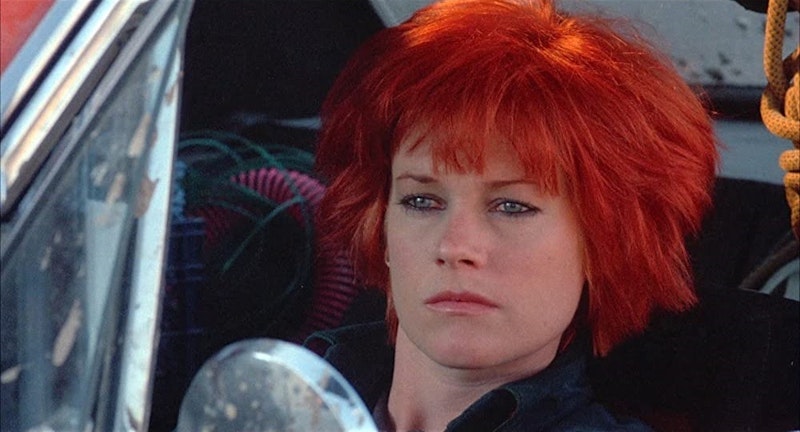In 2017, everyone will embrace eye-popping colors, plastic windbreakers, and some of the same technology we’ve ended up with. In our world, carburetors run alongside hybrids and Teslas; pedestrians talk to themselves with white pods drooling out of their ears; cigarettes and vapes are equally abundant. We’re living in an echo of Philip K. Dick, or a very early version, one where certain trains haven’t changed or renovated in 40 years, and self-checkouts have sprouted, nearly all useless. Broken technology and dirt—George Lucas saw this coming, too, and in Star Wars, you see a science fiction world more plausible than anything in Forbidden Planet or Dune.
Edward R. Pressman, late producer and soldier of cinema, presided over the mid-1980s Orion production Cherry 2000. Shot in 1985, the film follows David Andrews as he searches for a new model of his robot girlfriend, the titular Cherry. The models are mass-produced, but he has the only copy of her “personality disc.” The first scene of the movie is them about to fuck, but then the bathtub overflows and she fries. Unfixable, Andrews ventures out into the “zones”—specifically Zone 7, where he meets “trackers” Melanie Griffith and Ben Johnson. They’re living in familiar desert-as-apocalypse terrain, surrounded by guards and soldiers in ad-hoc uniforms repurposing tools of the old world to subjugate those that survived… whatever happened.
Cherry 2000 is, at times, remarkably evocative of Dick’s work, but all of that’s silenced by the film’s mid-1980s sitcom quips, physical “comedy,” and its predictably corny synth score. Ten years earlier, this might’ve been made by Roger Corman and his band of outsiders—actually, Cherry 2000 takes quite a bit from Death Race 2000—and it would’ve been harder. It would’ve been rougher and completely uninterested in trying to look and sound like a studio movie, or a television show. But even a bizarre tonal mashup like Cherry 2000—action dystopia, robot romance, Cornflakes joke writing—tries to be as appealing to as many people as possible, truly pleasing no one.
It’s a good movie, one with great costumes and production design that overshoot 2017 in many ways, but still retain the stuff that did stick around: khakis, hamburgers, guns. Everything’s illuminated and director Steve De Jarnatt does a fine job in an arrangement that reminds me of the violent and chaotic production of 1993’s Super Mario Bros. This movie didn’t come out until 1988 because Orion didn’t know what to do with it; even with Ed Phantom of the Paradise Pressman pushing, the studio shelved it until Melanie Griffith broke out with Working Girl. As soon as she was nominated for an Oscar, Cherry 2000 was finally available, albeit on home video, a movie Griffith would later call her worst, but one whose cult she respects.
I rented Cherry 2000 from Beyond Video in Baltimore two weeks ago and nearly returned it without watching, something that almost never happens; but at 98 minutes, and Griffith and Ben Johnson, it was worth checking out the first 20 minutes. Cherry 2000 is as plausible a depiction of the future as Blade Runner or its superior 2017 sequel; moreover, its means of evoking the future are both simple and still with us. Mostly, it’s repurposed garbage: construction cranes used to guard ad-hoc prison “zones,” toxic chemicals used as hair dye, and junky but funky looking cars flying through the air dodging bullets and rockets, not lasers.
Picking it out of the Cult section at a place like Beyond Video, itself an anomaly today, felt like time travel. Cherry 2000 was never released theatrically, and other than HBO, it’s lived in Cult sections its whole life.
—Follow Nicky Otis Smith on Twitter and Instagram: @nickyotissmith

